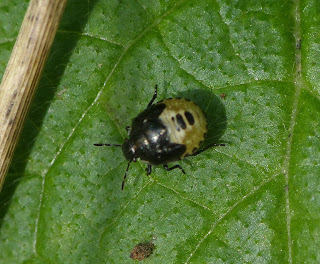The group visited this site a couple of years ago when, typically, in my absence as I was on holiday, they found 11 species of shieldbugs and allies.
Long overdue, we returned to The Haycop.
Would the shieldbugs still be there? I think the title of this report gives it away. Yes they were. However we only managed 9 species which is still pretty good.
The Haycop is tucked away at the end of an unmade lane sandwiched between Dark Lane and Ironbridge Road. It is not easy to find as proven by one very late arrival.
"You should have followed my directions." said I.
"I did." said he; adding with feeling "They were rubbish."
"Did you miss the right turn into Dark Lane after the traffic lights coming up from Jackfield?" asked I.
"What traffic lights?" retorted he.
"Did you come over the new bridge and up the hill? " asked I, thinking he may have come another way into Broseley.
"Yes." replied he.
"The traffic lights are about 200 yards after the u-bend." offered I
"Ah! I must have missed them." was his meek reply.
The site is in the hands of a private owner but he has given permission to a local conservation group to manage it as a nature reserve.
We were joined by four members of the group. They appear to be very active attracting large groups of helpers and spreading the word to the next generation. Long may they be well supported.
Our first shieldbug, Green, was found before we entered the site in the hedge bordering the lane.
 |
| Photograph: Jim Cresswell |
The site is entered via a kissing gate next to the "Down Well". This was Broseley's main source of water for many a year. It has now been protected by covering it with a roof made of local bricks and a fence. For some reason I did not photograph it but images can be found by searching the internet.
On entering the site there is an immediate fork in the path. Should we go down into the grassland and to the pool as shown in the above photograph, or should we take the path along the top through the trees.
I refused to make a decision as generally it is ignored. The mood of the group was to stay on the top path. So we did.
A cranefly, Tipula paludosa, was resting on a leaf.
 |
| Photograph: Jim Cresswell |
 |
| Photograph: Jim Cresswell |
Progress was slow but eventually we arrived at some heathland and a couple of neighbouring grasslands.
Progress halted here as we spent a long time, spanning lunchtime, investigating these three areas. Here are some of the things we found and photographed:
 |
| Pantilius tunicatus - Photograph: Jim Cresswell |
 |
| Halictus tumulorum (male) - Photograph: David Williams |
 |
| Field grasshopper - Photograph: David Williams |
 |
| Bishop's mitre - Photograph: David Williams |
 |
| Small grass shieldbug - Photograph: David Williams |
Again progress was snail-like as things just popped up saying, "Look at us".
 |
| Cola-nut gall on oak (caused by the gall wasp Andricus lignicola - Photograph: Jim Cresswell |
 |
| Myathropa florea - Photograph: Jim Cresswell |
 |
| Tachina fera - Photograph: Jim Cresswell |
 |
| Southern hawker - Photograph: Jim Cresswell |
The end was in sight but we did not rush to get there taking in a bank of vegetation, some of which had been cleared, and some rough grassland.
The site kept giving.
 |
| Woundwort shieldbug nymph - Photograph: Jim Cresswell |
 |
| Spiked shieldbug - Photograph: Jim Cresswell |
 |
| Dicranopalpus ramosus - Photograph: Jim Cresswell |
 |
| Dock bug (teneral adult) - Photograph: David Williams |
 |
| Comma butterfly larva - Photograph: David Williams |
 |
| Photograph: David Williams |
Finally, in case you were wondering, the three shieldbugs not mentioned in the text were:
Sloe (or Hairy) shieldbug
Hawthorn shieldbug
Birch shieldbug.
My thanks to The Haycop Conservation Group for permission to do what we enjoy doing, I wish them every success in the future. And thanks to the photographers Jim Cresswell and David Williams for their excellent photographs.































No comments:
Post a Comment
Please feel free to comment on this post...